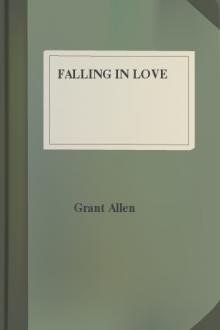Falling in Love by Grant Allen (different e readers .txt) 📕

- Author: Grant Allen
- Performer: -
Book online «Falling in Love by Grant Allen (different e readers .txt) 📕». Author Grant Allen
So much for the two sitters; now let us turn to the artist who sketched them. Who was he, and when did he live? Well, his name, like that of many other old masters, is quite unknown to us; but what does that matter so long as his work itself lives and survives? Like the Comtists he has managed to obtain objective immortality. The work, after all, is for the most part all we ever have to go upon. 'I have my own theory about the authorship of the Iliad and Odyssey,' said Lewis Carroll (of 'Alice in Wonderland') once in Christ Church common room: 'it is that they weren't really written by Homer, but by another person of the same name.' There you have the Iliad in a nutshell as regards the authenticity of great works. All we know about the supposed Homer (if anything) is that he was the reputed author of the two unapproachable Greek epics; and all we know directly about my old master, viewed personally, is that he once carved with a rude flint flake on a fragment of reindeer horn these two clumsy prehistoric horses. Yet by putting two and two together we can make, not four, as might be naturally expected, but a fairly connected history of the old master himself and what Mr. Herbert Spencer would no doubt playfully term 'his environment.'
The work of art was dug up from under the firm concreted floor of a cave in the Dordogne. That cave was once inhabited by the nameless artist himself, his wife, and family. It had been previously tenanted by various other early families, as well as by bears, who seem to have lived there in the intervals between the different human occupiers. Probably the bears ejected the men, and the men in turn ejected the bears, by the summary process of eating one another up. In any case the freehold of the cave was at last settled upon our early French artist. But the date of his occupancy is by no means recent; for since he lived there the long cold spell known as the Great Ice Age, or Glacial Epoch, has swept over the whole of Northern Europe, and swept before it the shivering descendants of my poor prehistoric old master. Now, how long ago was the Great Ice Age? As a rule, if you ask a geologist for a definite date, you will find him very chary of giving you a distinct answer. He knows that the chalk is older than the London clay, and the oolite than the chalk, and the red marl than the oolite; and he knows also that each of them took a very long time indeed to lay down, but exactly how long he has no notion. If you say to him, 'Is it a million years since the chalk was deposited?' he will answer, like the old lady of Prague, whose ideas were excessively vague, 'Perhaps.' If you suggest five millions, he will answer oracularly once more, 'Perhaps'; and if you go on to twenty millions, 'Perhaps,' with a broad smile, is still the only confession of faith that torture will wring out of him. But in the matter of the Glacial Epoch, a comparatively late and almost historical event, geologists have broken through their usual reserve on this chronological question and condescended to give us a numerical determination. And here is how Dr. Croll gets at it.
Every now and again, geological evidence goes to show us, a long cold spell occurs in the northern or southern hemisphere. During these long cold spells the ice cap at the poles increases largely, till it spreads over a great part of what are now the temperate regions of the globe, and makes ice a mere drug in the market as far south as Covent Garden or the Halles at Paris. During the greatest extension of this ice sheet in the last glacial epoch, in fact, all England except a small south-western corner (about Torquay and Bournemouth) was completely covered by one enormous mass of glaciers, as is still the case with almost the whole of Greenland. The ice sheet, grinding slowly over the hills and rocks, smoothed and polished and striated their surfaces in many places till they resembled the roches moutonnées similarly ground down in our own day by the moving ice rivers of Chamouni and Grindelwald. Now, since these great glaciations have occurred at various intervals in the world's past history, they must depend upon some frequently recurring cause. Such a cause, therefore, Dr. Croll began ingeniously to hunt about for.
He found it at last in the eccentricity of the earth's orbit. This world of ours, though usually steady enough in its movements, is at times decidedly eccentric. Not that I mean to impute to our old and exceedingly respectable planet any occasional aberrations of intellect, or still less of morals (such as might be expected from Mars and Venus); the word is here to be accepted strictly in its scientific or Pickwickian sense as implying merely an irregularity of movement, a slight wobbling out of the established path, a deviation from exact circularity. Owing to a combination of astronomical revolutions, the precession of the equinoxes and the motion of the aphelion (I am not going to explain them here; the names alone will be quite sufficient for most people; they will take the rest on trust)—owing to the combination of these profoundly interesting causes, I say, there occur certain periods in the world's life when for a very long time together (10,500 years, to be quite precise) the northern hemisphere is warmer than the southern, or vice versa. Now, Dr. Croll has calculated that about 250,000 years ago this eccentricity of the earth's orbit was at its highest, so that a cycle of recurring cold and warm epochs in either hemisphere alternately then set in; and such cold spells it was that produced the Great Ice Age in Northern Europe. They went on till about 80,000 years ago, when they stopped short for the present, leaving the climate of Britain and the neighbouring continent with its existing inconvenient Laodicean temperature. And, as there are good reasons for believing that my old master and his contemporaries lived just before the greatest cold of the Glacial Epoch, and that his immediate descendants, with the animals on which they feasted, were driven out of Europe, or out of existence, by the slow approach of the enormous ice sheet, we may, I think, fairly conclude that his date was somewhere about B.C. 248,000. In any case we must at least admit, with Mr. Andrew Lang, the laureate of the twenty-five thousandth century, that
'Twas the manner of primitive man.
The old master, then, carved his bas-relief in pre-Glacial Europe, just at the moment before the temporary extinction of his race in France by the coming on of the Great Ice Age. We can infer this fact from the character of the fauna by which he was surrounded, a fauna in which species of cold and warm climates are at times quite capriciously intermingled. We get the reindeer and the mammoth side by side with the hippopotamus and the hyena; we find the chilly cave bear and the Norway lemming, the musk sheep and the Arctic fox in the same deposits with the lion and the lynx, the leopard and the rhinoceros. The fact is, as Mr. Alfred Russel Wallace has pointed out, we live to-day in a zoologically impoverished world, from which all the largest, fiercest, and most remarkable animals have lately been weeded out. And it was in all probability the coming on of the Ice Age that did the weeding. Our Zoo can boast no mammoth and no mastodon. The sabre-toothed lion has gone the way of all flesh; the deinotherium and the colossal ruminants of the Pliocene Age no longer browse beside the banks of Seine. But our old master saw the last of some at least among those gigantic quadrupeds; it was his hand or that of one among his fellows that scratched the famous mammoth etching on the ivory of La Madelaine and carved the figure of the extinct cave bear on the reindeer-horn ornaments of Laugerie Basse. Probably, therefore, he lived in the period immediately preceding the Great Ice Age, or else perhaps in one of the warm interglacial spells with which the long secular winter of the northern hemisphere was then from time to time agreeably diversified.
And what did the old master himself look like? Well, painters have always been fond of reproducing their own lineaments. Have we not the familiar young Raffael, painted by himself, and the Rembrandt, and the Titian, and the Rubens, and a hundred other self-drawn portraits, all flattering and all famous? Even so primitive man has drawn himself many times over, not indeed on this particular piece of reindeer horn, but on several other media to be seen elsewhere, in the original or in good copies. One of the best portraits is that discovered in the old cave at Laugerie Basse by M. Elie Massénat, where a very early pre-Glacial man is represented in the act of hunting an aurochs, at which he is casting a flint-tipped javelin. In this, as in all other pictures of the same epoch, I regret to say that the ancient hunter is represented in the costume of Adam before the fall. Our old master's studies, in fact, are all in the nude. Primitive man was evidently unacquainted as yet with the use of clothing, though primitive woman, while still unclad, had already learnt how to heighten her natural charms by the simple addition of a necklace and bracelets. Indeed, though dresses were still wholly unknown, rouge was even then extremely fashionable among French ladies, and lumps of the ruddle with which primitive woman made herself beautiful for ever are now to be discovered in the corner of the cave where she had her little prehistoric boudoir. To return to our hunter, however, who for aught we know to the contrary may be our old master himself in person, he is a rather crouching and semi-erect savage, with an arched back, recalling somewhat that of the gorilla, a round head, long neck, pointed beard, and weak, shambling, ill-developed legs. I fear we must admit that pre-Glacial man cut, on the whole, a very sorry and awkward figure.
Was he black? That we don't certainly know, but all analogy would lead one to answer positively, Yes. White men seem, on the whole, to be a very recent and novel improvement on the original evolutionary pattern. At any rate he was distinctly hairy, like the Ainos, or aborigines of Japan, in our own day, of whom Miss Isabella Bird has drawn so startling and sensational a picture. Several of the pre-Glacial sketches show us lank and gawky savages with the body covered with long scratches, answering exactly to the scratches which represent the hanging hair of the mammoth, and suggesting that man then still retained his old original hairy covering. The few skulls and other fragments of skeletons now preserved to us also indicate that our old master and his contemporaries much resembled in shape and build the Australian black fellows, though their foreheads were lower and more receding, while their front teeth still projected in huge fangs, faintly recalling the immense canines of the male gorilla. Quite apart from any theoretical considerations as to our probable descent (or ascent) from





Comments (0)